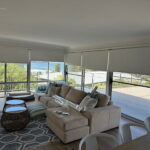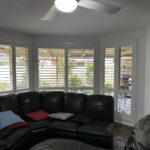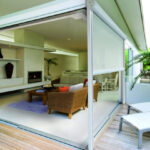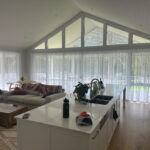Do Roller Blinds Cause Condensation
If you’ve ever noticed water droplets forming on your windows, especially in the mornings, you may have wondered — do roller blinds cause condensation?
The short answer is no, roller blinds don’t directly cause condensation. However, in some situations, they can contribute to it by trapping a pocket of warm air between the blind fabric and the cold glass. This trapped air cools down, and when the temperature drops, condensation can form on the window surface.
Understanding why this happens — and how to prevent it — can help you enjoy the benefits of roller blinds without unwanted moisture problems in your home.
At The Blind Crew, we often get this question from Central Coast homeowners who love the look and practicality of roller blinds but want to keep their windows and walls dry and mould-free. Here’s everything you need to know.
Check out our Blinds by Room guide and Blinds by Window guide for expert advice on choosing the perfect window coverings for every space and window style in your home.
See also Our Electric Blinds and Smart home options.

Understanding Condensation
Before answering do roller blinds cause condensation, it’s important to understand what condensation actually is.
Condensation occurs when warm, moist air meets a cold surface, like a windowpane. The temperature difference causes the moisture in the air to turn into liquid droplets.
This is most common in rooms like bathrooms, kitchens, and bedrooms, where humidity is higher and ventilation may be limited. It’s a natural occurrence, but when roller blinds are closed tightly against the window, the trapped air can make it worse.
So, Do Roller Blinds Cause Condensation?
Technically, roller blinds don’t cause condensation — they simply change how air flows around your windows.
When closed, especially on cooler nights, roller blinds can trap a layer of warm, moist air between the fabric and the glass. Since this air is no longer circulating freely, it cools down faster, and condensation is more likely to form on the inside of the window.
In other words, roller blinds don’t create moisture — they just create conditions where it can get trapped more easily.
This is why you might notice condensation forming more often in winter or in rooms with less airflow. The good news? With the right setup and habits, it’s easy to prevent.
How Roller Blinds Contribute to Condensation
There are three main reasons roller blinds can make condensation appear more frequently on your windows:
1. Trapping Warm Air
When roller blinds are fully closed, they create a pocket of air between the blind fabric and the glass.
This trapped air stays warmer than the window itself, and when the two temperatures meet, moisture forms on the glass. Over time, this can lead to visible water droplets and even mould growth around the window frame if left unchecked.
If you’re wondering do roller blinds cause condensation because they trap air, the answer is yes — but only when airflow is limited.
2. Reducing Air Circulation
Another reason condensation builds up is because the air behind the blind can’t circulate.
When air movement is restricted, the moisture-laden air that would normally disperse stays in contact with the glass longer. As it cools, it condenses into water droplets.
This is most noticeable in small bathrooms, kitchens, or bedrooms where windows are kept shut and the blinds remain down for long periods.
3. Preventing Evaporation
Finally, roller blinds can slow down evaporation by keeping the moisture trapped. Even after condensation forms, the lack of airflow behind the blind means it takes longer for the water to evaporate.
This can result in damp patches, water stains, or mould if your window frames are timber.
When asking do roller blinds cause condensation, this factor is often overlooked — but it’s one of the easiest to fix by improving airflow and choosing the right fabric.
How to Prevent Condensation with Roller Blinds
You don’t have to sacrifice your blinds to stop condensation. A few simple steps can help you maintain good airflow and prevent moisture build-up while keeping your roller blinds looking and performing at their best.
1. Ensure Good Ventilation
The most effective way to reduce condensation is to increase airflow. Open your windows for at least 10–15 minutes each day to allow fresh air to circulate and carry away humidity.
If your home has exhaust fans in bathrooms or kitchens, use them regularly to expel moist air before it settles on windows.
Ventilation is especially important on the Central Coast, where coastal humidity can intensify condensation in winter.
2. Leave a Small Gap
Instead of closing your roller blinds tightly against the sill, leave a small gap at the bottom.
This gap allows air to flow behind the blind and reduces the chance of trapped warm air condensing on the glass.
It’s a simple adjustment that can make a noticeable difference.
3. Open Blinds During the Day
Whenever possible, open your blinds during the day — especially in rooms prone to moisture.
Sunlight and air movement naturally dry out any condensation that forms overnight. This routine also prevents mould growth and keeps your blinds in better condition.
4. Choose Breathable Fabrics
If you’re installing roller blinds in high-humidity areas like bathrooms or laundries, choose breathable or moisture-resistant materials.
PVC or blackout fabrics can sometimes trap more heat and moisture against the window. Instead, look for lighter, woven fabrics designed to allow gentle airflow.
When homeowners ask do roller blinds cause condensation in bathrooms, we often recommend PVC blinds that are specifically treated to resist mould and moisture damage.
5. Consider Other Blind Types
If condensation is a recurring issue in your home, you might benefit from blinds that promote airflow.
Vertical blinds, Venetian blinds, or plantation shutters all allow better air circulation since they don’t sit flush against the glass.
For example, vertical blinds can be tilted to let air flow while still maintaining privacy — a great solution for rooms with condensation concerns.
You can explore more about these options in our Roller Blinds Central Coast and other product pages to find what works best for your home.
Local Advice and Installation
At The Blind Crew, we help Central Coast homeowners find the perfect window coverings for both style and practicality.
We understand the local climate and know how humidity and temperature fluctuations can affect blinds over time. Our mobile showroom brings samples of fabrics, materials, and finishes right to your home so you can choose the most suitable option for your environment.
We service all areas including Terrigal, Avoca Beach, Erina, and Wamberal, ensuring every installation is perfectly fitted to prevent air gaps and minimise condensation risks.
Summary
So, do roller blinds cause condensation?
No, they don’t directly cause it — but they can contribute to it by trapping warm air, reducing airflow, and slowing evaporation behind the blind.
With proper ventilation, a small gap for air circulation, and regular maintenance, you can prevent condensation easily while still enjoying the comfort and sleek style of roller blinds.
For expert installation and tailored advice, contact The Blind Crew today using the form below, call 1800 337 338, or email hello@theblindcrew.com.au to book your free measure and quote anywhere on the Central Coast.
Looking for blinds in your local area? Find your suburb here to see if The Blind Crew services your location.
Please Note: The Blind Crew specialises exclusively in the supply and installation of custom-made blinds, shutters, and awnings.
We do not offer blind cleaning or repair services.
For trusted maintenance options, visit Jim’s Cleaning Blinds Division 131 546 or Amazing Blind Repairs 1300 138 150.
Fast Turnaround – Blinds, Shutters & Outdoor Awnings Installed Quickly
- Roller blinds: Installed within just a few days (pending fabric stock by Australian suppliers)
- Electric Motors: Installed within just a few days (pending Stock)
- Indoor blinds: (vertical, venetian, roman, panel): 7–14 days
- Plantation shutters: 3–4 weeks
- Outdoor blinds & awnings: 3–4 weeks
